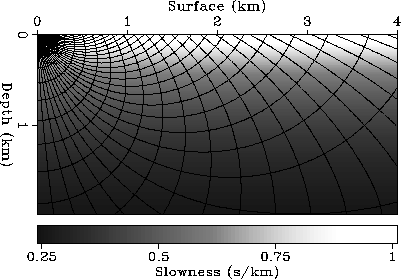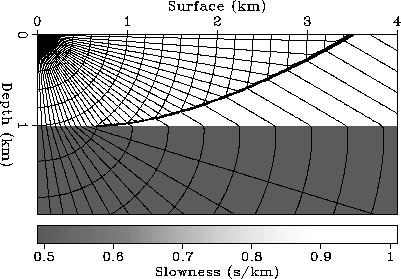




Next: Amplitudes
Up: EXAMPLES
Previous: EXAMPLES
The traveltime calculation algorithm can handle virtually arbitrary
slowness models. Figure ![[*]](http://sepwww.stanford.edu/latex2html/cross_ref_motif.gif) shows the results for a medium
in which velocity linearly increases with depth.
The velocity gradient is
1.5 1/sec. The background of this figure shows the slowness model.
I plot contour lines of the traveltimes on this background. The contour
lines of the traveltimes are the trajectories of the wavefronts. We see
that the wavefronts are stretched downward because the slowness
decreases with depth. Because the function
shows the results for a medium
in which velocity linearly increases with depth.
The velocity gradient is
1.5 1/sec. The background of this figure shows the slowness model.
I plot contour lines of the traveltimes on this background. The contour
lines of the traveltimes are the trajectories of the wavefronts. We see
that the wavefronts are stretched downward because the slowness
decreases with depth. Because the function  defined
in equation (14) is constant along
each ray, I plot the contour lines of this function to show the rays.
The values of the contours are uniformly spaced so that the rays plotted
are shot with uniform take-off angles. As expected,
we see many overturned rays.
ttmraygra
defined
in equation (14) is constant along
each ray, I plot the contour lines of this function to show the rays.
The values of the contours are uniformly spaced so that the rays plotted
are shot with uniform take-off angles. As expected,
we see many overturned rays.
ttmraygra
Figure 2 Wavefronts and rays for a model with a velocity function that is
linearly increasing as a function of depth. The background shows the slowness
model. The source is at the upper left corner of the figure. The traveltime
contour lines are drawn at 0.1 second intervals.





The slowness model in the second example
is a medium with two layers. The velocity contrast between the top
layer and the bottom layer is 1 to 2. Figure ![[*]](http://sepwww.stanford.edu/latex2html/cross_ref_motif.gif) shows the results
of the calculations. The content of this figure is similar to
Figure
shows the results
of the calculations. The content of this figure is similar to
Figure ![[*]](http://sepwww.stanford.edu/latex2html/cross_ref_motif.gif) . We see the first arrivals associated with both
transmitted
waves and refracted waves. We see the transmitted rays but not the
rays refracted along the interface. This is because all the refracted
rays originate from a single ray; therefore the values of
the function
. We see the first arrivals associated with both
transmitted
waves and refracted waves. We see the transmitted rays but not the
rays refracted along the interface. This is because all the refracted
rays originate from a single ray; therefore the values of
the function  along all the refracted rays are equal.
The thick curve that appears in the top layer is the boundary that separates
the first arrivals from the transmitted waves and the refracted waves.
along all the refracted rays are equal.
The thick curve that appears in the top layer is the boundary that separates
the first arrivals from the transmitted waves and the refracted waves.
ttmraylay
Figure 3 Wavefronts and rays for a model with two constant-velocity layers.
The background shows the slowness model. The source is
at the upper left corner of the figure. The traveltime
contour lines are drawn at 0.2 second intervals.





The final example for the traveltime calculation uses a slowness model
containing an anomaly with large velocity contrast.
The results of the calculations are
shown in Figure ![[*]](http://sepwww.stanford.edu/latex2html/cross_ref_motif.gif) .
The looping contour lines within the anomaly are due to the finite grid
sizes. Clearly, in the lower right part of the anomaly,
the first arrivals propagate back toward the source. This part is calculated
by backward extrapolation.
.
The looping contour lines within the anomaly are due to the finite grid
sizes. Clearly, in the lower right part of the anomaly,
the first arrivals propagate back toward the source. This part is calculated
by backward extrapolation.
ttmrayrec
Figure 4 Wavefronts for a model with a sharply-contrasted anomaly.
The background shows the slowness model. The source is
at the upper left corner of the figure. The traveltime
contour lines are drawn at 0.05 second intervals.










Next: Amplitudes
Up: EXAMPLES
Previous: EXAMPLES
Stanford Exploration Project
12/18/1997

![[*]](http://sepwww.stanford.edu/latex2html/cross_ref_motif.gif) shows the results for a medium
in which velocity linearly increases with depth.
The velocity gradient is
1.5 1/sec. The background of this figure shows the slowness model.
I plot contour lines of the traveltimes on this background. The contour
lines of the traveltimes are the trajectories of the wavefronts. We see
that the wavefronts are stretched downward because the slowness
decreases with depth. Because the function
shows the results for a medium
in which velocity linearly increases with depth.
The velocity gradient is
1.5 1/sec. The background of this figure shows the slowness model.
I plot contour lines of the traveltimes on this background. The contour
lines of the traveltimes are the trajectories of the wavefronts. We see
that the wavefronts are stretched downward because the slowness
decreases with depth. Because the function 
